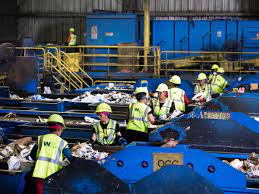Introduction
The global waste management system underwent a seismic shift when China, once the largest importer of recyclable materials, enacted its “National Sword” policy in 2018. This policy banned the import of 24 types of waste, including plastics and paper, leaving countries like the United States grappling with the challenge of managing their recyclables domestically. The question, “How does the US recycle waste after China’s ban?” is pivotal to understanding the country’s evolving recycling strategies, challenges, and opportunities.
This article explores the impact of China’s ban on US recycling, the steps taken to adapt, and what the future holds for sustainable waste management in America.
The Impact of China’s Recycling Ban
Why Was China’s Ban Implemented?
China’s decision to ban waste imports stemmed from environmental and health concerns. The imported recyclables often contained high levels of contamination, leading to pollution and inefficiencies in processing. The “National Sword” policy aimed to:
- Protect China’s environment.
- Encourage domestic recycling efforts.
- Halt the inflow of poorly sorted or contaminated waste.
Effects on US Waste Management
Before the ban, the US exported about 30% of its recyclables to China. Key materials included:
- Plastics: Nearly 776,000 tons annually.
- Paper: Over 13 million tons annually.
The immediate effects of the ban included:
- Piles of recyclables accumulating in facilities.
- Increased reliance on landfills and incineration.
- Financial strain on local recycling programs.
How Does the US Recycle Waste After China’s Ban?
Domestic Recycling Infrastructure
The US has taken significant steps to expand its domestic recycling capabilities to process waste locally.
Investment in Recycling Facilities
State and federal governments, alongside private companies, have invested in:
- Advanced sorting technology.
- New processing plants for plastics and paper.
For example, several states, including California and Oregon, have introduced grants and subsidies to support recycling infrastructure development.
Improved Sorting Techniques
Recycling contamination was a major issue pre-ban. The US has focused on improving sorting processes through:
- AI-based systems: These technologies help identify and separate recyclables more efficiently.
- Public awareness campaigns: Encouraging consumers to rinse containers and avoid mixing non-recyclables with recyclables.
Local Processing
States like Michigan and Pennsylvania have developed their own recycling hubs, reducing the reliance on international markets.
New Export Destinations
After the Chinese ban, the US began exporting recyclables to alternative markets, such as:
- Southeast Asia: Countries like Malaysia, Vietnam, and Thailand.
- India and Turkey: Emerging markets for waste imports.
However, many of these countries have also started imposing stricter regulations due to the challenges of managing imported waste.
Circular Economy Initiatives
The shift to a circular economy focuses on:
- Reducing waste at the source: Encouraging businesses to minimize packaging and use sustainable materials.
- Product redesign: Creating items that are easier to recycle.
- Extended Producer Responsibility (EPR): Holding manufacturers accountable for the end-of-life management of their products.
Legislative Actions
Federal and state governments have implemented several policies to enhance recycling practices, including:
- Plastic bag bans: Enacted in states like California and New York.
- Recycling mandates: Encouraging the use of post-consumer recycled materials in production.
- Grants for innovation: Funding research on sustainable waste management technologies.
Challenges in Post-Ban Recycling
Financial Strain
Recycling is more expensive than landfilling due to:
- High operational costs of advanced facilities.
- Fluctuating market prices for recyclables.
Limited Infrastructure
While progress has been made, the US still lacks sufficient facilities to process all recyclables domestically.
Contamination
Consumer habits continue to contribute to contamination in recycling streams, reducing the efficiency of processing facilities.
Export Market Volatility
Alternative export markets have imposed their own restrictions, creating uncertainty in the global recycling trade.
Data Analysis: Recycling Trends Post-China Ban
Recycling Rates Before and After the Ban
| Year | Total Recycling Rate (%) | Plastics Recycling Rate (%) | Paper Recycling Rate (%) |
| 2017 (Pre-Ban) | 35 | 9 | 66 |
| 2018 (Post-Ban) | 32 | 7 | 64 |
| 2022 (Current) | 34 | 8 | 68 |
Innovations Driving the Future of Recycling
Advanced Technologies
Technological advancements are key to addressing recycling challenges:
- Chemical recycling: Breaks down plastics into their chemical components for reuse.
- Robotic sorting systems: Increase accuracy and efficiency.
- Pyrolysis: Converts mixed plastic waste into fuel or raw materials.
Collaborative Efforts
Partnerships between government, businesses, and nonprofits are fostering innovation. For instance:
- The Recycling Partnership: Works to improve curbside recycling programs.
- Closed Loop Partners: Invests in circular economy solutions.
The Path Forward
To answer “How does the US recycle waste after China’s ban?”, it’s clear that the country has made strides but faces ongoing challenges. Moving forward, the US must:
- Expand domestic processing capabilities.
- Strengthen policies to encourage sustainable practices.
- Foster innovation to make recycling more efficient and cost-effective.
By prioritizing these goals, the US can build a more resilient and sustainable waste management system.
FAQs
What is the National Sword policy?
The National Sword policy is China’s 2018 regulation banning the import of certain waste materials, including plastics and paper, to improve environmental quality.
Why did China stop accepting recyclables?
China’s decision was driven by high contamination levels in imported recyclables, which caused environmental and processing issues.
How can consumers help improve recycling?
Consumers can:
- Reduce contamination by cleaning recyclables.
- Avoid mixing non-recyclables with recyclables.
- Support local recycling initiatives.

Leave a Reply